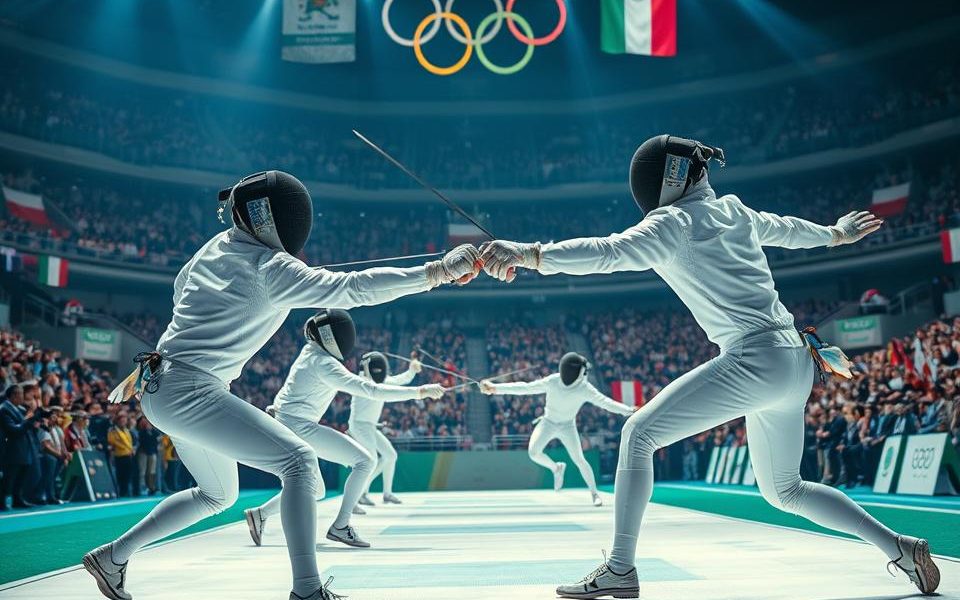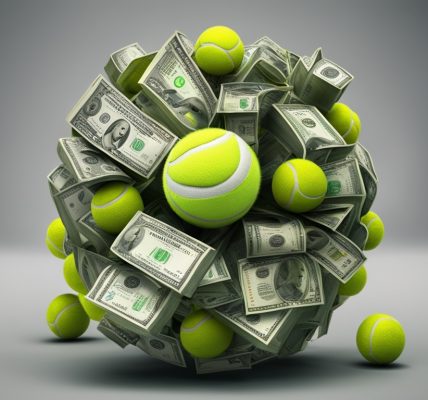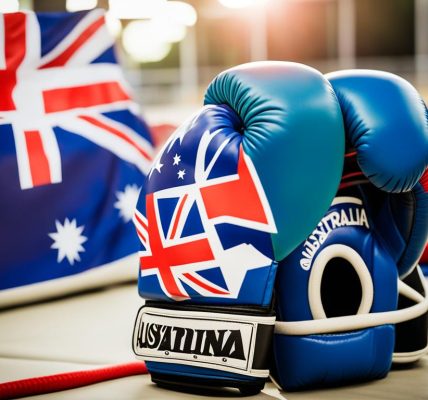The Olympic Games have always been a place for top-notch sports events. Fencing is one of these, with its long history and exciting matches. It has captured the hearts of people for centuries, making the Olympics even more thrilling.
Fencing at the Olympics shows off the skill and hard work of its athletes. This article will cover the interesting facts and history of fencing. It will talk about where it came from, how it has changed, and the famous champions it has seen.
If you love fencing or want to learn more about it, this deep dive into Olympic fencing is for you. It will take you right into the action, where the sound of swords and the cheers of the crowd make the atmosphere electric.
Read more interesting information at ::ds-collection
The Origins of Olympic Fencing
The sport of fencing has a long and interesting history. It started as a way to fight and has become the exciting Olympic event we see today.
Fencing’s Roots in Ancient Times
The history of fencing goes back to ancient times. The Greeks, Romans, and Asians used sword skills for combat. These early fighters trained hard to master their weapons.
The jogo do pau, a Portuguese stick-fighting style, started in the 16th century. Other European martial arts also existed, setting the stage for modern fencing.
The Transition to Modern Fencing
Over time, fencing changed from a combat skill to a sport. New weapons like the foil, épée, and sabre were introduced. Rules and scoring systems made it a competitive sport.
The first Olympic fencing events were at the 1896 Summer Games in Athens, Greece. Since then, fencing has kept fans interested with its mix of skill, strategy, and tradition.
“Fencing is a sport of mind as much as body. The fencer must be thinking three or four moves ahead, anticipating the opponent’s actions and counteractions.”
Fencing Events at the Olympics
The olympic fencing events are a key part of the Olympic Games. Fans and fencing lovers look forward to these events. They show the sport’s athleticism, strategy, and beauty.
Individual and Team Competitions
The olympic fencing events have both individual and team competitions. Each one has its own set of challenges. Individual events test a fencer’s skill and quick thinking. Team events show how fencers work together, highlighting the sport’s teamwork and friendship.
The individual olympic fencing events include:
- Men’s Foil, Epee, and Sabre
- Women’s Foil, Epee, and Sabre
In team events, fencers represent their countries together. They compete in:
- Men’s Foil, Epee, and Sabre
- Women’s Foil, Epee, and Sabre
These olympic fencing events are exciting. They mix speed, precision, and strategy. This makes them a key part of the Olympic Games.
“Fencing is a game of physical chess, where the mind and body must work in perfect harmony to outmaneuver your opponent.”
Fencing Equipment and Techniques
Fencing is a sport with a rich history and tradition. It requires special equipment and technical skills. Let’s explore the fencing equipment and techniques that make this sport unique.
The Weapons of Fencing
Fencing uses three main weapons: the foil, the epee, and the sabre. Each weapon has its own rules and requires specific skills. The foil is for precise strikes, the epee for any body part, and the sabre for speed and aggression.
Fundamental Fencing Techniques
- Lunging: A powerful forward movement to deliver a strike
- Parrying: The art of deflecting an opponent’s attack
- Riposte: The immediate counterattack following a successful parry
- Footwork: The intricate steps and movements that allow fencers to maneuver effectively
- Feinting: Deceptive actions used to create openings for attacks
These techniques, along with strategy and quick reflexes, are key to fencing success. They require years of practice and a deep understanding of the sport.
| Fencing Weapon | Characteristics | Target Area |
|---|---|---|
| Foil | Flexible blade, emphasis on precision | Torso |
| Epee | Heavier blade, scoring for any part of the body | Entire body |
| Sabre | Quicker movements, scoring for cuts above the waist | Above the waist |
“Fencing is the art of fighting with a sword, and the most beautiful of all sports.” – Napoleon Bonaparte
Fencing equipment and techniques show the sport’s depth and complexity. From the unique weapons to the skilled moves, fencing combines physical skill and strategy. It captivates people all over the world.
Fencing Olympics Facts: A Look at the Numbers
Fencing has a long history at the Olympic Games, filled with exciting statistics and records. These numbers show its lasting popularity and excellence. Let’s explore the fencing olympics facts together and be amazed by the numbers that define this thrilling sport.
One amazing fact is the large number of medals given out in fencing over the years. Since the first modern Olympics in 1896, fencing has been a key part of the Games. Athletes have competed in individual and team events for foil, epee, and sabre. Thousands of athletes have fought for these medals, making a lasting impact on the sport.
| Fencing Event | Total Medals Awarded | Records Held |
|---|---|---|
| Individual Foil | 324 | Italy’s Giorgio Santelli with 5 gold medals |
| Individual Epee | 289 | Hungary’s Aladar Gerevich with 7 gold medals |
| Individual Sabre | 324 | Russia’s Stanislav Pozdnyakov with 4 gold medals |
| Team Foil | 144 | Italy with 12 gold medals |
| Team Epee | 140 | France with 10 gold medals |
| Team Sabre | 144 | Russia with 10 gold medals |
These numbers highlight the talent in fencing and the lasting impact of its champions on the Olympics. The fencing olympics facts show how this sport continues to thrill fans and inspire athletes to excel.
“Fencing is the perfect combination of physical and mental prowess, where strategy and precision converge to create moments of pure athletic brilliance.” – Olympic Fencing Legend, Aleksandr Romankov
Legendary Fencing Champions
Fencing is a sport that shows the best of human skill, athleticism, and willpower. Over the years, a few fencing champions have stood out, making a lasting impact. They’ve won big, inspiring others to chase their fencing dreams.
Fencing Greats Through the Ages
Edoardo Mangiarotti, an Italian fencer, was a legend in the mid-20th century. He won six Olympic gold medals over two decades, becoming one of the most successful fencing champions ever.
Valentina Vezzali, an Italian foil fencer, is another legend. She won six Olympic golds, ten world titles, and many other honors. Her achievements have made her a true legend in fencing.
| Fencer | Nationality | Medals | Notable Achievements |
|---|---|---|---|
| Edoardo Mangiarotti | Italian | 6 gold, 1 silver | One of the most decorated fencing champions in Olympic history |
| Valentina Vezzali | Italian | 6 gold, 2 silver, 2 bronze | Considered one of the greatest fencing champions of all time |
These fencing champions and others have made a big impact on the sport. They inspire athletes to aim high and explore the limits of fencing.
The Art of Fencing Strategy
Fencing is more than a sport; it’s a dance of quick decisions and smart moves. At the Olympics, top fencers show off their skills and strategy. They mix athleticism with tactical smarts.
To win in Olympic fencing, athletes need to know their opponents well. They study their rivals’ strengths and weaknesses. Then, they plan how to beat them.
The key to fencing strategy is distance control. Fencers keep the right distance from their opponents. This lets them control the pace and strike at the best time. Quick reflexes and good footwork are needed for this.
Being mentally strong is also key. Olympians must stay calm and make quick decisions. Reading their opponent’s body language helps them guess what’s coming next.
“Fencing is a physical chess match, where the mind and body work in perfect harmony to outmaneuver the opponent.” – Jemima Jewell, Olympic Fencing Champion
The art of fencing strategy shows how deep and complex the sport is. It’s about controlling distance and making quick decisions. The world’s top fencers push the limits of what’s possible. They impress with their skills and strategy.
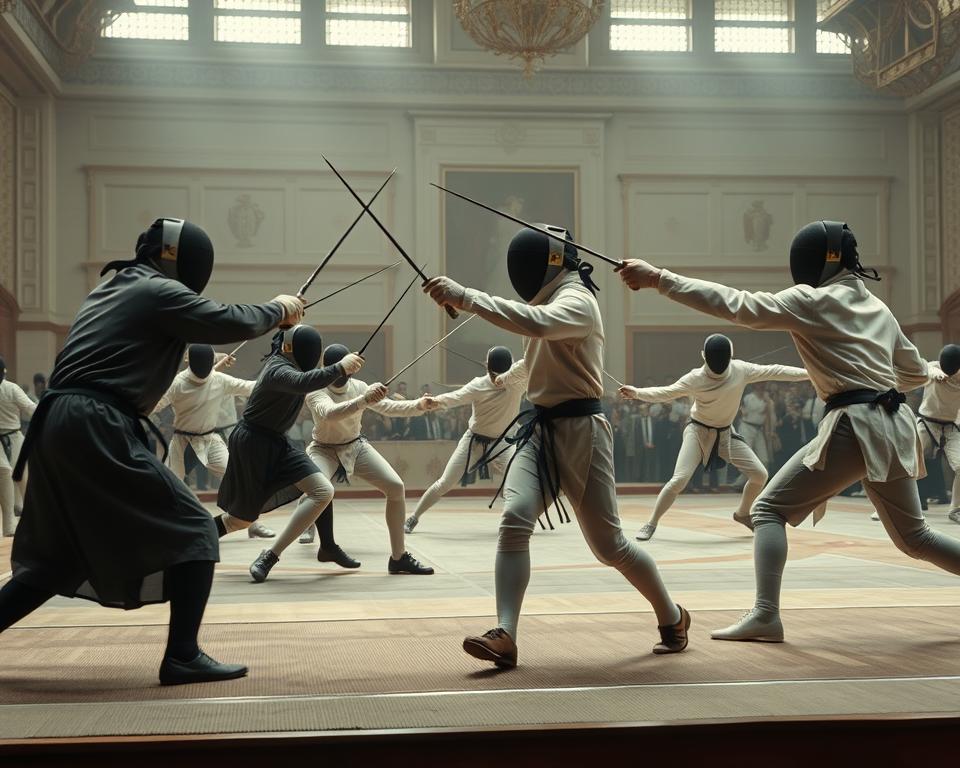
| Fencing Technique | Description | Importance in Strategy |
|---|---|---|
| Parry | A defensive action used to deflect an opponent’s attack | Crucial for maintaining control of the distance and countering attacks |
| Riposte | An immediate counterattack following a successful parry | Allows fencers to seize the initiative and gain the upper hand |
| Feint | A false attack used to draw out a reaction from the opponent | Effective for setting up more powerful attacks and exploiting weaknesses |
| Remise | A continuous attack when the initial attack is parried | Demonstrates adaptability and the ability to maintain momentum |
Fencing and the Olympic Spirit
Fencing is deeply tied to the Olympic movement’s core values. It has been part of the Olympics since 1896. Throughout its history, fencing has always kept high standards of ethics and fair play.
Sportsmanship and Respect
Olympic fencing is all about camaraderie and respect among competitors. Fencers commit fully to the sport’s rules. They congratulate their opponents, no matter the result.
This culture of sportsmanship is celebrated worldwide. Fencers from everywhere come together to show their skills and share their love for the sport.
The fencing community values etiquette and civility. Fencers salute their opponents, judges, and the audience. This shows the respect and honor in the sport.
This spirit of friendship and understanding shows the Olympic Games’ enduring values. Excellence is pursued, but so is the recognition of fellow competitors.
“Fencing is a sport that demands the highest levels of sportsmanship and respect. It is not just about physical prowess, but also about the ability to conduct oneself with grace and integrity, both in victory and in defeat.”
Fencers are seen as ambassadors of the Olympic spirit. They set an example for athletes in all sports. By living by the values of sportsmanship and respect, fencing inspires and captivates people worldwide.
The Thrill of Olympic Fencing
The fencing olympics facts show the excitement and drama of the Olympic Games. This ancient sport has been thrilling fans for ages. It’s known for intense rivalries, close finishes, and the electric vibe of olympic fencing events.
Fencing at the Olympics is a mix of speed and strategy. Athletes perform lightning-fast moves and play a strategic game of feints and counterattacks. The crowd watches with bated breath as athletes clash, their blades meeting in a dance that decides the winner.
The thrill of Olympic fencing grows with its mix of individual and team events. Seeing a team work together is amazing. They use their skills to beat their opponents and win for their country.
“Fencing is like a game of chess, but with swords. The tension and drama are palpable as the athletes engage in a game of wits and skill.”
Olympic fencing tests athletes’ mental strength under pressure. The crowd’s cheers, the sound of blades clashing, and the moments of victory or defeat make it a captivating event.
Whether you’re a fan or new to fencing, the fencing olympics facts will keep you on the edge of your seat. It showcases skill, strategy, and athleticism. It’s a true celebration of human spirit, excellence, and the thrill of competition.
Fencing’s Impact on Popular Culture
Fencing, an ancient art of sword fighting, has always caught the public’s eye. It has made its mark on both the big screen and classic books. This elegant sport has left a lasting impact on popular culture.
Fencing in Film and Literature
For years, daring fencers have been a key part of Hollywood movies. Films like The Princess Bride, Star Wars, and The Mask of Zorro have shown off the sport’s drama and skill. In books, authors like Alexandre Dumas and Sir Arthur Conan Doyle have also highlighted fencing’s rich history.
Fencing is loved for its mix of physical skill and strategic thinking. Fans are drawn to the grace and precision of fencers. Their battles of wits and speed have made fencing a lasting part of popular culture.
| Fencing in Film | Fencing in Literature |
|---|---|
| The Princess Bride | The Count of Monte Cristo by Alexandre Dumas |
| Star Wars | The Adventures of Sherlock Holmes by Sir Arthur Conan Doyle |
| The Mask of Zorro | The Three Musketeers by Alexandre Dumas |
The sport of fencing keeps growing and winning over fans around the world. Its influence on popular culture is set to last. The exciting sword fights, the mental challenge, and the athletes’ skill keep making fencing a favorite among artists and storytellers.
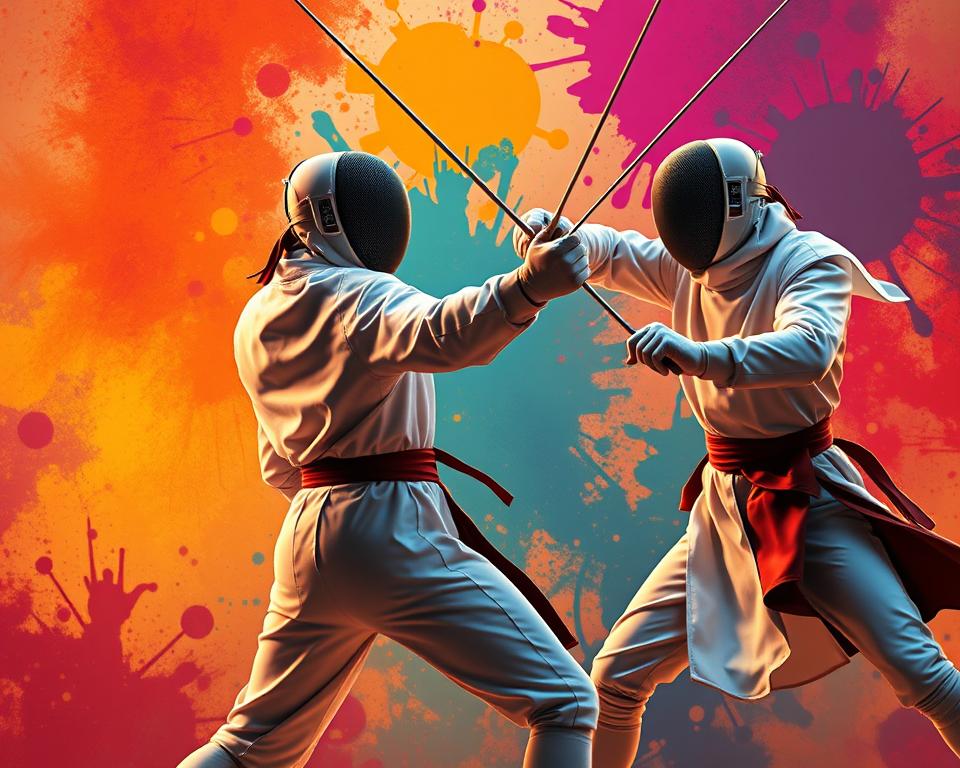
The Future of Fencing at the Olympics
The olympic fencing events have always been a big hit around the world. They show off the amazing skills, strategies, and athleticism of fencers. This sport has been a key part of the Olympics for a long time.
New ideas and changes keep making fencing olympics facts exciting. Fencers use the latest technology and rules to make the sport better and more competitive.
People all over the world are working hard to keep fencing popular. They help new talent grow and make sure it stays in the Olympics. This includes small local programs and big international events. Fencing fans and experts are key to the sport’s future.
Everyone is getting ready for the next Summer Olympics, and the excitement for olympic fencing events is high. Fans will see incredible moves, sharp skills, and strong minds as the best fencers fight for gold medals.
The fencing olympics facts show that fencing has a bright future. It keeps drawing in fans and inspiring new athletes. This makes it one of the top events at the Olympics.
Fencing: A Test of Mental and Physical Prowess
Fencing is a sport that requires top mental and physical skills. Elite fencers work hard to improve their skills for competitions. They need to be quick and focused to beat their opponents.
The Discipline and Training Required
Fencing training is known for being tough and detailed. Aspiring Olympians spend many hours perfecting their skills. They work on their technique, endurance, and strategy.
- They do intense physical training to get faster, stronger, and more agile.
- They practice technique drills to get the right form and footwork for each weapon.
- They spar a lot to get used to the competition’s pressure and make better tactics.
- They also do mental exercises to stay focused and calm under stress.
Fencers face the risk of getting hurt. They can get muscle strains, joint sprains, or even concussions. They work with trainers and doctors to prevent injuries and keep training safely.
By being dedicated and committed, fencers improve their skills and become top athletes. They can then perform well at the Olympic Games.
The Worldwide Fencing Community
Fencing has a vibrant global community, all sharing a love for this dynamic sport. It brings together athletes, fans, and spectators from around the world. The fencing world is full of international organizations and top events.
Fencing Organizations and Events
Major international groups like the International Fencing Federation (FIE) lead the fencing community. They work hard to promote and develop the sport. They organize competitions, training, and programs to grow fencing globally.
The Fencing Olympics is a highlight of the fencing calendar. It brings together the world’s best fencing athletes. There are also world championships, regional tournaments, and special events. These offer chances for fencing community members to meet, compete, and celebrate their love for fencing.
| Major Fencing Events | Description |
|---|---|
| Fencing Olympics | The premier fencing competition, held as part of the Olympic Games |
| FIE World Championships | The annual world championship event organized by the International Fencing Federation |
| Regional Championships | Competitions held across different continents and zones, such as the European and Pan-American Championships |
| World Cup and Grand Prix | A series of elite international competitions that form the annual fencing circuit |
Thanks to these events and the hard work of fencing groups, the fencing community is thriving. It’s helping the sport grow and gain more fans worldwide.
Conclusion
The history of fencing at the Olympic Games is both rich and captivating. It goes back to ancient times and has grown into today’s dynamic competitions. Fencing has always been a mix of athleticism, strategy, and sportsmanship.
Through the fencing olympics facts we’ve learned, we see the sport’s lasting appeal. These facts highlight the dramatic moments and the global community that keeps fencing alive. Whether it’s the fast foil, the elegant sabre, or the strategic epee, fencing shows the human spirit’s pursuit of excellence.
Looking ahead, fencing’s future is bright with new achievements and innovative approaches. The fencing olympics facts we’ve shared are just the start. They promise to inspire and captivate future generations.
